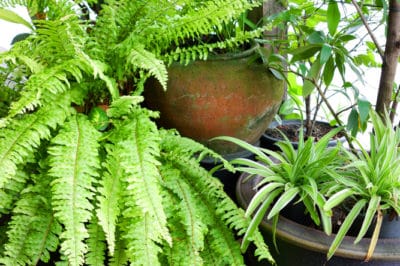Visual Aspects
Boston fern is a bright green all year around. The fronds can grow to a height of three feet, with a graceful arch that makes it a natural for container planting and hanging baskets. A healthy Boston fern will also develop mini plants around its margin. Many people describe the fronds and tiny leaves as having a feather-like appearance.
Best Locations Inside
Your Boston fern will do best in any area with indirect light – it grows in dappled or full shade outdoors. Since it appreciates high humidity and plenty of warmth, conservatories, kitchens and especially bathrooms are ideal locations. It can become quite large, though, so make sure you have room for a mature plant. If grown in other areas, you’ll need to mist it at least twice a day.
Choosing Containers
A healthy Boston fern can grow to considerable size. You’ll want the container to have room for its roots, but you should also consider how you’ll move it if necessary. Hanging pots should have secure fastenings for chains or cords. Unglazed ceramic may allow too much evaporation, especially in winter when it’s dry indoors. Make sure the pot has adequate drainage.
The Right Soil
As long as the soil drains well, Boston fern isn’t too fussy about the soil type. Here are some choices:
- Standard commercial potting soil.
- Commercial potting soil mixed with and equal amount of good garden compost.
- Peat moss, perlite and potting soil in equal parts.
- Equal parts peat moss, perlite or vermiculite and compost or leaf mold.
The Right Water
Like many houseplants, Boston ferns are sensitive to chemicals in tap water. Chlorine and fluoride can both cause problems, while commercial water softening chemicals may also be an issue. It’s probably better to use rainwater or distilled water when watering or misting the plant. Room temperature water is also a better choice, as the plant prefers warmth.
Propagating Boston Fern
In the wild, ferns propagate through spores. Commercial growers use tissue cultures. However, if your Boston fern likes its growing situation, it will begin to send up small miniature plants around the outside of the mother. Once these have developed root systems, they can be repotted into a small pot and grown on to expand your collection or for gifts. You can also divide mature plants.
